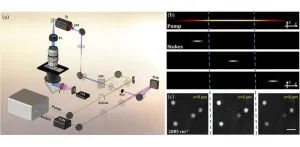(Press-News.org) Data from a series of randomized trials in the United States suggests that if teachers move genetics instruction toward more complex genomics concepts, they can help students have a more scientifically accurate understanding of race. This can protect students from believing in unscientific notions of genetic essentialism, including the idea that inequality is genetic. People who believe in genetic essentialism believe – among other ideas – that most racial differences are determined by genes. Essentialist beliefs are a biological misconception. Around the world, students receive a basic genetics education that focuses on single-gene in-heritance; students learn Mendel’s laws of heredity, and how different versions of a gene (i.e., alleles) are inherited across generations through probabilistic mechanisms that are easily modeled by a Punnett square. This is a risk factor for the development of genetic essentialism during adolescence, say Brian Donovan and colleagues in their Policy Forum. They advocate for teaching genomic concepts in a way that refutes genetic essentialism in a framework they call “humane genomics education.” The authors point to randomized controlled trials (RCTs) conducted in the U.S. that already demonstrate that teaching 8th- to 12th-grade students about key related concepts can cause a reduction in students’ genetic essentialist beliefs about race. One of these concepts is that most genetic variation occurs within geographic populations, rather than across them. Results of related studies show students taught such concepts are more likely to disbelieve genetic essentialism because they are more likely to develop the perception that races are not that genetically different. However, these past RCTs have had key limitations, say the authors. To overcome them, they designed new cluster-randomized crossover trials – in which all participating clusters receive both intervention treatments (human genomics education) and control treatments (basic genetics education) consecutively, in separate time periods. Their studies were the first to explore how these two instruction styles affect racial conceptualization.
Between December 2019 and May 2022, the authors recruited 15 teachers and 1063 biology students from six U.S. states (Colorado, Illinois, Indiana, Kansas, New Jersey, and Massachusetts). Participating teachers received 40 hours of professional development to learn how to implement humane genomics intervention. According to results, students participating in the humane genomics classroom setting exhibited greater knowledge of genomics and less belief in genetic essentialism. Importantly, as students begin to disbelieve genetic essentialism, they also appeared to gravitate toward the belief that race is a social concept and that racial disparities are caused by prejudice. Basic genetics instruction, by contrast, yielded none of these benefits to students. To address concerns about scalability of their approach, the authors described results of an additional preregistered person-randomized trial they conducted with about 1000 under-graduates in the University of California system. Results suggest that humane genomics instruction can be scaled in a relatively cost-effective, time-efficient manner through an online platform, the authors say. “Several humane genomics learning experiences spread over many years of biology instruction will be needed to reduce the prevalence of genetic essentialist beliefs,” say the authors.
END
Moving “beyond Mendel” in genetics education can reduce racism, new study suggests
2024-02-22
ELSE PRESS RELEASES FROM THIS DATE:
Uncovered with JWST: A neutron star in the remnant of Supernova 1987A
2024-02-22
Astronomers using the James Webb Space Telescope (JWST) have found conclusive evidence of a neutron star in the remnant of Supernova 1987A, the only supernova visible to the naked eye in the last 400 years and the most studied supernova in history. Although Supernova 1987A has been observed for more than three decades, scientists have not seen the compact object expected to have been produced during the explosion. Some indirect evidence had suggested that the supernova produced a neutron star, but a black hole wasn’t ruled ...
Chemistry and albedo feedbacks offset forestation’s net climate benefits
2024-02-22
Roughly a third of the climate cooling that forests achieve by removing carbon dioxide (CO2) from the atmosphere is offset through changes to atmospheric composition and decreased surface reflectivity, researchers report. The findings suggest that the benefits of wide-scale forestation efforts may be overestimated and do not represent a single solution for addressing climate change. They also highlight the urgency of simultaneously focusing on emissions reductions. Planting trees has been widely promoted as a nature-based solution to remove anthropogenic CO2 from the atmosphere to help mitigate ...
Snakes do it faster, better: How a group of scaly, legless lizards hit the evolutionary jackpot
2024-02-22
More than 100 million years ago, the ancestors of the first snakes were small lizards that lived alongside other small, nondescript lizards in the shadow of the dinosaurs.
Then, in a burst of innovation in form and function, the ancestors of snakes evolved legless bodies that could slither across the ground, highly sophisticated chemical detection systems to find and track prey, and flexible skulls that enabled them to swallow large animals.
Those changes set the stage for the spectacular diversification of snakes over the past 66 million years, allowing them to quickly exploit new opportunities ...
Side effects of wide scale forestation could reduce carbon removal benefits by up to a third
2024-02-22
The side effects of large-scale forestation initiatives could reduce the CO2 removal benefits by up to a third
Researchers at the University of Sheffield used computer models, which simulate the land, ocean and atmosphere, to investigate the impact of forestation under future climate scenarios
While forestation increases atmospheric CO2 removal, it also changes atmospheric composition and darkens the land surface, reducing its potential to tackle climate change
Combining forestation with other climate mitigation ...
Yale chemists synthesize unique anticancer molecules using novel approach
2024-02-22
New Haven, Conn. — Nearly 30 years ago, scientists discovered a unique class of anticancer molecules in a family of bryozoans, a phylum of marine invertebrates found in tropical waters.
The chemical structures of these molecules, which consist of a dense, highly complex knot of oxidized rings and nitrogen atoms, has attracted the interest of organic chemists worldwide, who aimed to recreate these structures from scratch in the laboratory. However, despite considerable effort, it has remained an elusive task. Until now, that is.
A team of Yale chemists, writing in the journal Science, ...
Maynooth University partners in study published in Science that finds evidence of elusive neutron star
2024-02-22
A new study, published in Science and co-authored by Dr Patrick Kavanagh of Maynooth University’s Department of Experimental Physics in Ireland, has provided the first conclusive evidence for the presence of the elusive neutron star produced in the supernova SN 1987A.
Supernovae are the spectacular end result of the collapse of stars more massive than eight to ten times the mass of the sun. Besides being the main sources of chemical elements such as the carbon, oxygen, silicon, and iron that make life possible, they are also responsible for creating the ...
James Webb telescope detects traces of neutron star in iconic supernova
2024-02-22
Scientists can finally show that a neutron star formed from our most well-studied supernova, SN 1987A. The breakthrough was made possible thanks to the James Webb telescope.
Supernovae are the spectacular end result of the collapse of stars more massive than 8-10 times the mass of the sun. Besides being the main sources of chemical elements such as carbon, oxygen, silicon, and iron that make life possible, they are also responsible for creating the most exotic objects in the universe, neutron stars and black holes.
In 1987, supernova 1987A (SN 1987A) ...
Enhanced 3D chemical imaging with phase-modulation
2024-02-22
Understanding complex biological and biomedical systems is greatly aided by 3D imaging, which provides much more detailed information than traditional two-dimensional methods. However, live cell and tissue imaging remain challenging due to factors like limited imaging speed and significant scattering in turbid environments.
In this context, multimodal microscopy techniques are notable. Specifically, nonlinear techniques like CRS (coherent Raman scattering) use optical vibrational spectroscopy, providing precise chemical imaging in tissues and cells in a label-free way. Furthermore, stimulated Raman scattering (SRS) ...
Researchers harness 2D magnetic materials for energy-efficient computing
2024-02-22
CAMBRIDGE, MA — Experimental computer memories and processors built from magnetic materials use far less energy than traditional silicon-based devices. Two-dimensional magnetic materials, composed of layers that are only a few atoms thick, have incredible properties that could allow magnetic-based devices to achieve unprecedented speed, efficiency, and scalability.
While many hurdles must be overcome until these so-called van der Waals magnetic materials can be integrated into functioning computers, MIT researchers took an important step in this direction by demonstrating precise control of a van der ...
Empowering autistic teens: New clinician advice for navigating chronic pain
2024-02-22
When you’re an autistic teenager living with chronic pain, getting treatment for your pain can be a challenging experience. That’s according to a group of young people who’ve spoken to Dr. Abbie Jordan of the Department of Psychology and Centre for Pain Research at The University of Bath about their experiences. Teenagers mention sensory issues, a lack of autism awareness among staff, or feeling “doubly different” compared to their peers, making receiving “one-size-fits-all” psychologically focused treatment for their chronic pain ...



